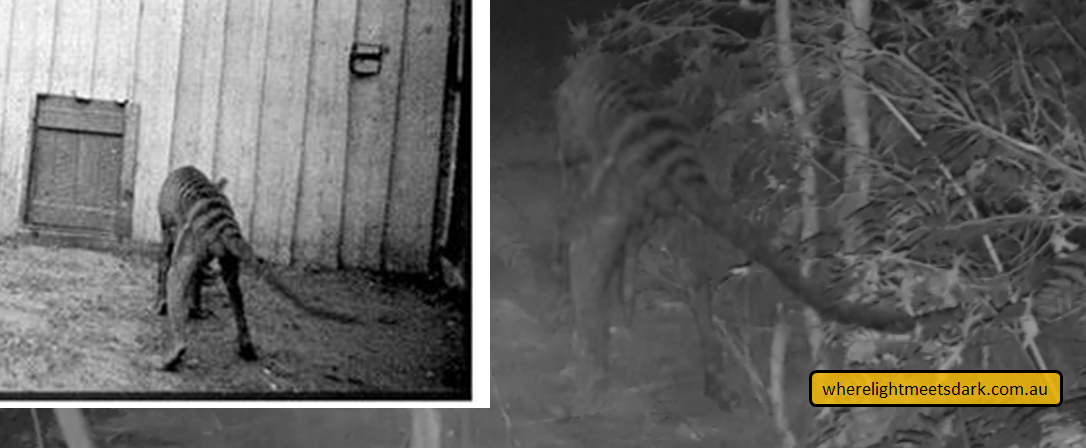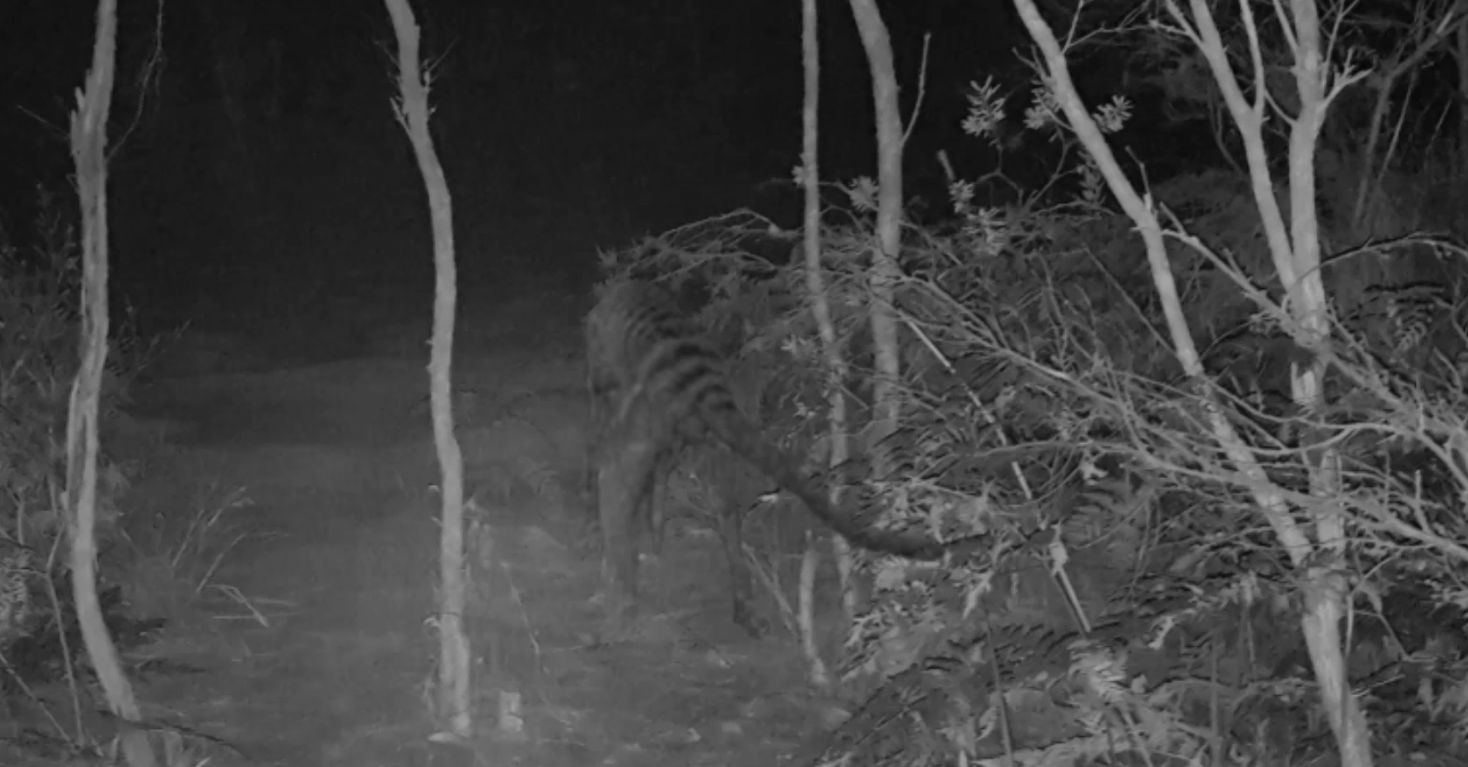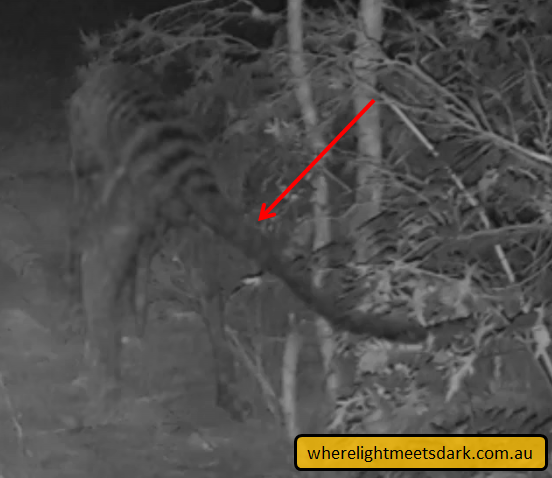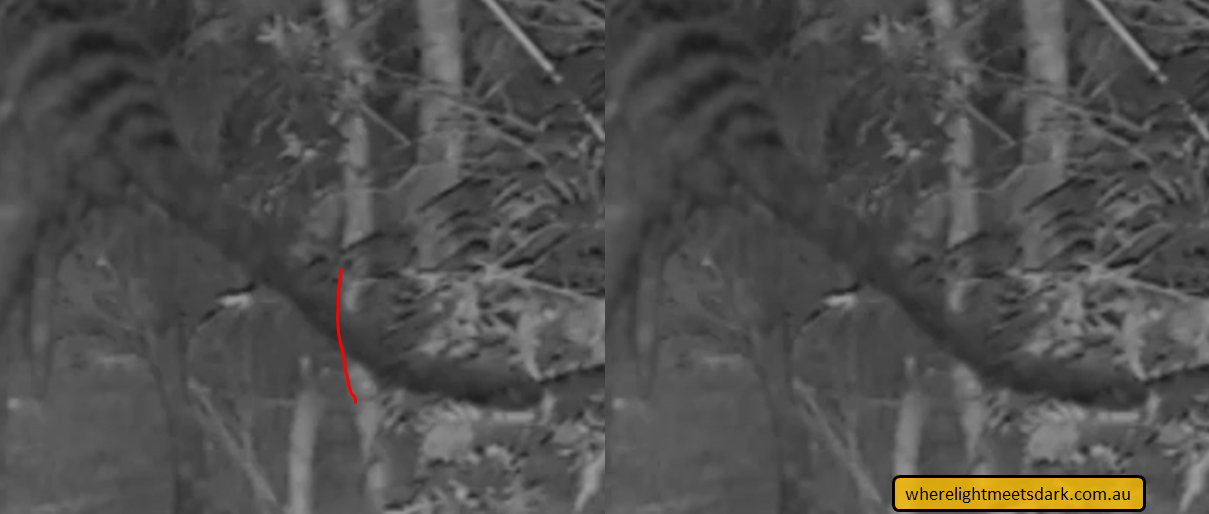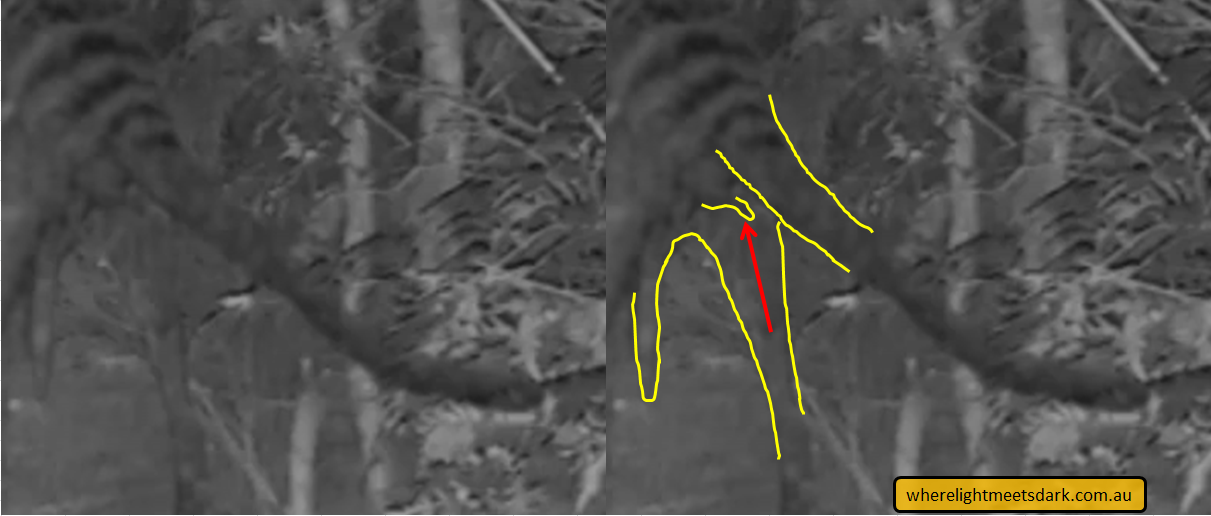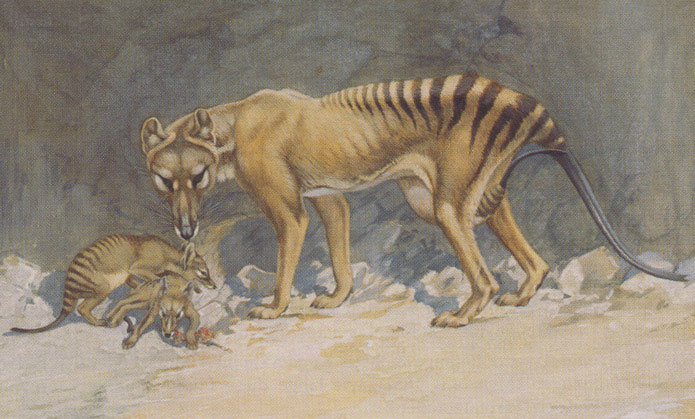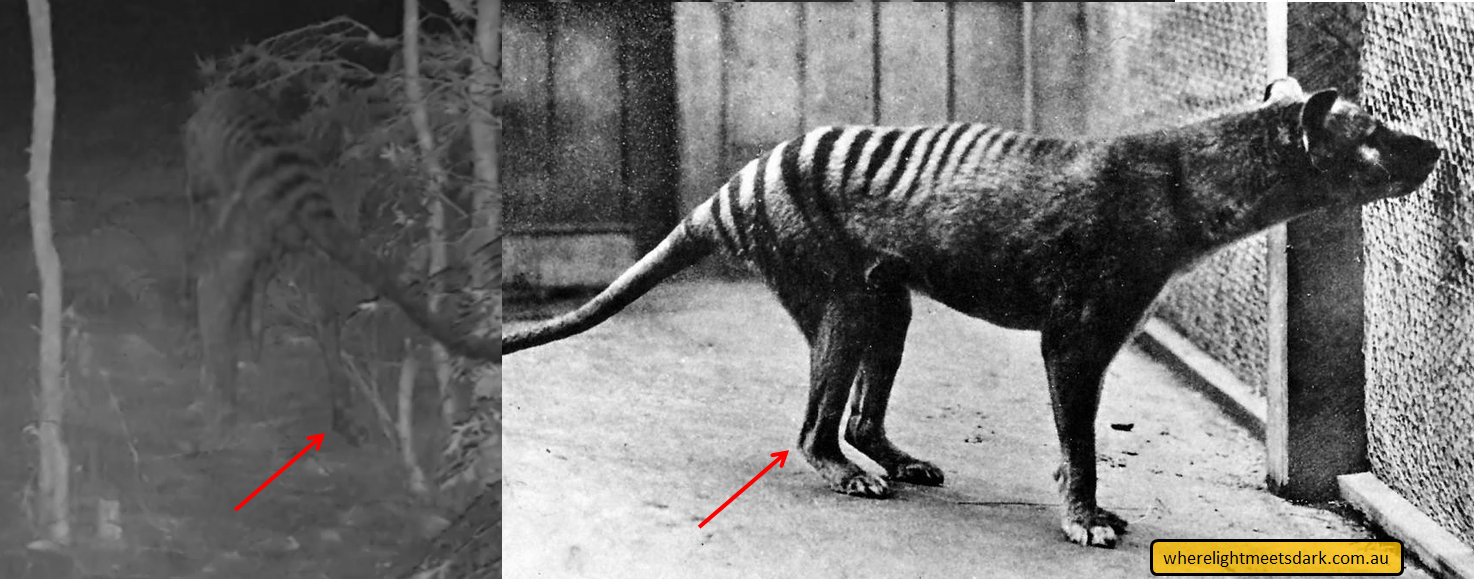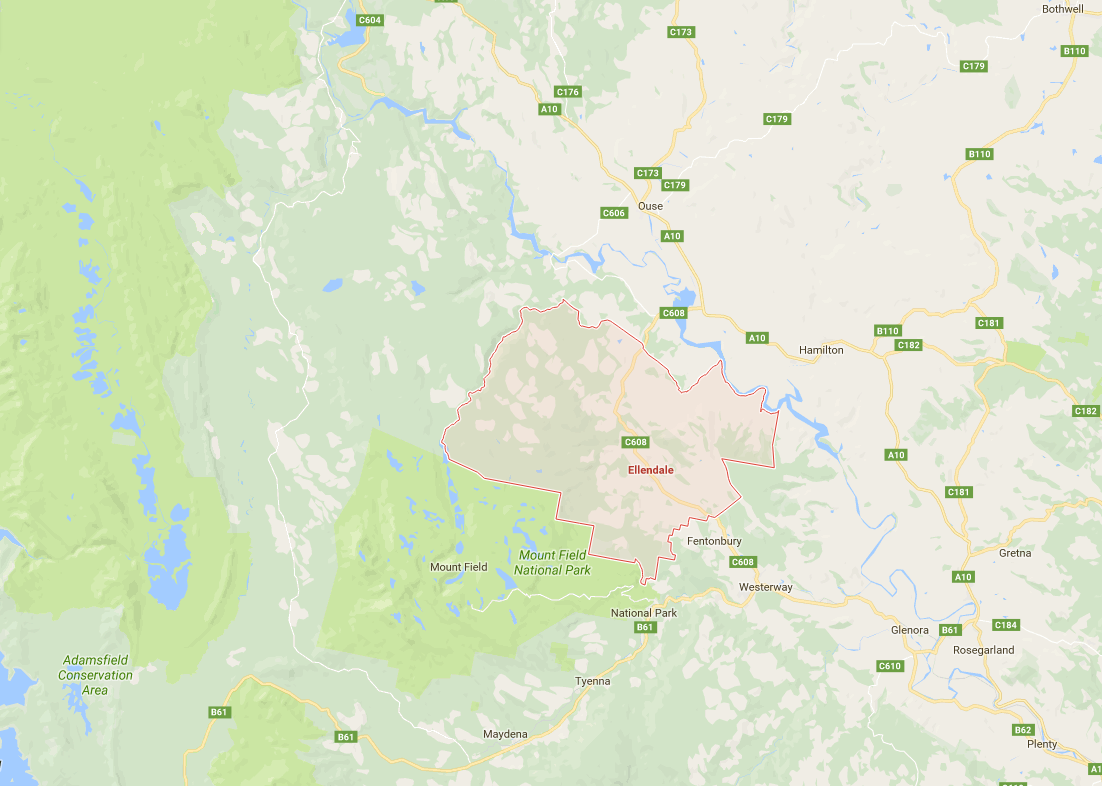Ellendale thylacine 2016
Stop Press!
Do readers think the thylacine in the YouTube clip matches that from this historical photograph?
Thanks to Dean for raising my awareness to it.
- Read the Ellendale thylacine 2016 debunked article
Debunked
31 May 2017
This article was originally published approximately 6:00 on 31 May 2017, then shared to the WLMD Facebook page. Reader Dean Alex quickly identified that the thylacine in this image is nearly identical to one in a known still frame, as now shown above.
This "Debunked" section is added as an aftermath addendum. The original conclusion holds true - that this shows a thylacine and that persons with the resources could produce an image of this quality. The example given was that the film industry could prepare such an image. Finally, taken at face value, the image seemed to hold promise.
The side by side comparison above, however, shows that the stripe pattern on the thylacine is identical, except for a slight horizontal expansion (ie. widening) of the animal. In particular, a pale streak down the left hand flank is visible in both images also. The photograph of the known thylacine does show, I believe, pouch young. In fact, in researching the original article I was searching for exactly this image of a mother with pouch young walking away from the camera, but could not locate it. Instead, the painting depicted below was shared. The apparent striping of the pouch young in the original photo has been obfuscated in the YouTube image. [See note below, under "1 June 2017", for clarification.]
Further to note is that the apparently unusual tail length, and tail kink, both match the historical image. However in the historical image, the tail kink may be a combination of a shorter animal tail terminating (in the photo) exactly where a background mark on the ground is found. Regardless, the "transparency" in the tail of the YouTube animal (mentioned below) does, in retrospect, provide evidence of the digital manipulation that is likely to have gone into creating the YouTube image. While this digital manipulation may seem obvious in hindsight, in truth many camera trap images are pixellated to the degree seen in the YouTube clip.
Open questions remain as to the identity of the person, persons or group that posted the YouTube video, the person whose voice is disguised in the video, the person who prepared this image and whether this clip relates to the news announced on Triple M Hobart at the start of the year (where voice was also disguised). I have annecdotal reports that today's YouTube clip has no relationship to the news announced earlier this year, despite apparent similarities in the story. This may be evidence of a third party attempting to copycat the original story for motives unknown.
1 June 2017
Two more videos appeared under the same YouTube account overnight, offering additional images and clarifying that these are camera trap photographs, not still frames from videos. If the owner would like to submit the original camera trap photographs I would be more than happy to provide a further analysis.
In yesterday's update I mentioned seeking to locate an image of a mother walking away from the camera, with pouch young and that the historical photograph identified by Dean (at the top of this page) was one and the same. This is incorrect. The photograph identified by Dean was taken in 1911 by Mr Tucker. You can view Tucker's 1911 photograph in the Online Thylacine Museum.
The image I actually had in mind was a film clip, captured in 1928, that shows several thylacines in an enclosure. One of these walks away from the camera and through a small doorway which is similar in appearance to the one in Tucker's 1911 photograph. You can view the film of the 1928 mother thylacine with pouch young walking away from the camera, also in the Online Thylacine Museum.
At the time of Tucker's photograph there were two males and a female in the enclosure. The thylacine apparently used in the Youtube video is a male and as such, does not show a female with pouch young. The "apparent striping" mentioned erroneously yesterday, is due to markings on the ground "behind" the thylacine (ie. further away from the camera; in real life the marks are in front of the thylacine, which is facing away from the camera).
Read the Ellendale thylacine 2016 debunked article
Overview
In May 2017 a video was published to Youtube showing a photograph alleged to have come from a trail camera, or camera trap. The photograph appears to show a Tasmanian tiger (Thylacinus cynocephalus, or thylacine) walking along a trail and away from the camera. The audio consists of a person talking about the capture and the property on which the capture occurred. The person's voice has been digitally altered, according to text that is displayed during the video.
According to text in the video, the trail camera captured video footage of the tiger and the owner of the footage is in negotiations to sell the footage to a production company for use in a documentary.
The video was published by "Thylacine Sightings Tasmania" with the caption "This image was captured near Ellendale, Tasmania, in 2016. Video footage has also been captured. At present I only have permission to use this one image and the interview. The audio of the voice has been digitally altered." It is the only video published under this YouTube account.
Video
Below is the video, as presented on Youtube.
Text from video
The text captions presented during the video read as follows:
TASMANIAN TIGER
(Thylacine)
Game Trail Camera Image
Near Ellendale - Tasmania
2016
ALL RIGHTS RESERVED
The Family Who Captured This Image Wishes To Remain Anonymous.
The Voice Of The Farmer Has Been Digitally Altered
Towards the end of the video, the following text is also presented:
The Game Trail Camera
Also Captured Video Of The
Tiger Passing.
Legal Advice Has Been Sought And
An Australian Television Network
Has Entered Negotiations To Purchase
The Footage For A Documentary
Audio transcript
During the clip, the digitally altered voice of "the farmer" is heard giving the following explanation:
"My father bought the farm here in Ellendale back in 1923 and he actually trapped a few tigers when he was a young lad. He worked a mine up at Warratah actually and he was shown how to do it with a couple of the old bushies up there. He got a couple down here up at the back of Ellendale. I believe that was before that one at the zoo died and he hasn't seen any since then, in his time, but he did say he heard one on occasion but that was in the 1940s I believe, when I was still quite young.
I saw one in 1968. We were out spotlighting for wallabies and we got a few and looked up the track to see if we could see any more and this thing looking back at us - at first I thought it was a dog - but it turned around and it had stripes! My mate actually took a shot at it but I don't think he hit it because it ran off into the forest and that was the last we saw of it and the last I ever saw one; well the only time I ever saw one, actually.
But my son, about two years ago, was on a logging road and I was actually with him that day but I wasn't... He was further away from the vehicle - we got out of the vehicle, a ute - and he was up the track a bit and he saw one, really, really close! I didn't believe him at first but he convinced me of what he saw and I've got no reason to disbelieve him. And I'm convinced now because we purchased these camera trap things that a friend of ours put us onto. I think they're called stealth cameras or something along those lines. He set - my son set one up on a tree on a kind of a bit of a path where animals and maybe people have walked before, out, not far from where he saw this one a couple of years ago. A lot of things came back on them - mostly wallabies, all kinds of things, possums but eventually he got the back of it! He got the back of the tiger, and that's what this is, about this interview, so ah...
Photograph
Following is the photograph shown in the interview.
Analysis
A few things stand out regarding the morphology of this animal.
It is not clear whether this image was captured as a still frame photograph or whether it is a still frame taken from a video. The black and white colouration is expected of a camera trap using infrared flash at night. Under these conditions, camera traps produce greyscale images.
Long tail
Firstly, the animal appears to have a long tail. However, see my Animal Size Study on Facebook where I show that even small changes in the distance of an animal from the camera trap can make apparently large differences to the appearance of the size of the animal.
Likewise, in this image, the tail exaggeration may be explained by its being closer to the camera than the animal's body.
Striped or banded tail
A short portion of the tail shows what appears to be pale banding as shown below.
While the Tasmanian tiger does not have stripes on its tail, its tail could sometimes appear striped due to the vertebrae creating ridges which cast shadows. This may be the case in this image.
Tail is slightly transparent
At one point the tail passes in front of a small tree trunk, which is in the background. The left edge of that tree trunk appears visible where it is expected to cross the tail of the animal - see the closeup, below.
While this may be a cause for concern, there are other regions in the image showing significant pixelation - including in front of the same tree just above where the tail transects it. The effect may be due to the animal's movement combined with a long shutter speed. If this was a photograph captured by the camera - as opposed to a still frame from a video clip - then the shutter speed should be able to be determined from the EXIF (metadata) information associated with the photo. However this will not be present in the Youtube video. Personally, I find this a notable detail but not necessarily inconsistent with the expected quality of a trail camera image.
Pouch young?
If the genital region of the animal is inspected closely, there appears to be a tiny protrusion which may be consistent with the tail of a very small pouch young. See the image below.
There are very few photographs or film footage still frames showing adult female thylacines with pouch young in pouch. The painting by Joseph M Gleeson shown below illustrates how the pouch young lay within the pouch, with tail protruding as possibly seen in the YouTube image above.
If the YouTube image shows pouch young, then the young would appear smaller than that shown in the painting.
While new research exists by Sleightholme and Campbell giving a reconsidered calendar for the Tasmanian tiger's breeding season, the YouTube video only presents year of capture (2016) and not month. Therefore we cannot attempt to compare the size of the possible pouch young with what would be expected for the time of year at which this capture was made.
Hind leg morphology
The animal's right rear leg is clearly visible with its joints. As can be seen from the photograph of the thylacine below, the Tasmanian tiger's hock is very low placed. This appears consistent between the YouTube capture and what is known of the thylacine.
Stripes
The stripes appear boldest at the rump, just above the hind leg. The striping pattern appears to stop where the tail starts. Although the front half of the animal is viewed obliquely, it appears the striping pattern is not prominent on the anterior half of the animal's back. All of these features are characteristic of the Tasmanian tiger and visible in the composite image above on both the YouTube animal and the known thylacine image.
Location
The farmer explains that this animal was photographed in or near Ellendale, Tasmania. The region is illustrated, via Google Maps, below.
Ellendale is adjacent to Mount Field National Park. Maydena can be seen at the bottom of the map. The road through Maydena heads west into Tasmania's south-west wilderness. Adamsfield Conservation Area is shown to the west and is the region in which a thylacine was allegedly shot in 1990 according to the photograph and story presented by Col Bailey in his second book. The shaded green area containing many patches of white is logging forest, consistent with the farmer's mention of being on logging roads with his son at an earlier date. The white patches are logging coupes. The other green (shown at Mount Field and to the west) is protected forest. This general area is the region of the Florentine Valley which is where the last Tasmanian tigers were trapped in the wild in the 1920s and early 1930s. The region west of Mount Field includes the "thylacine corridor" written about by Col Bailey where he concludes thylacines migrate from the Weld Valley (not shown, to the south), north-west toward central Tasmania.
Altogether the location was formerly prime thylacine habitat, though now very much modified by logging.
It is likely this still frame relates to the news story broken in early 2017 whereby a man phoned Hobart radio station Triple M to announce he had seen a thylacine film clip captured by an acquaintance's trail camera, as that claim was made for this general region. Voice modification was used during that interview also, to keep the caller anonymous.
Back story
The farmer mentions his family acquiring the property in 1923 and that his father had captured some thylacines about that time. There is an extensive record of thylacine captures during the 1900s and the claim may be verified by cross referencing the known record. However there are also many claims of people sighting or interacting with thylacines but not putting those interactions on public record. As such, cross referencing the claim may add legitimacy to the story but being unable to cross reference does not discount the story.
Conclusion
The animal in the YouTube video appears to be a thylacine.
The statement has been made many times that evidence of the thylacine will not be accepted without the production of a body, preferably alive. However, well documented photographic or video evidence may be accepted.
The reality is that if a film production company wished to produce a video such as the one we see here, there is no doubt it can be done. The film The Hunter presents a reasonably realistic thylacine animation and the image we have to consider in this YouTube video is merely a greyscale still frame, at that.
However if we take the evidence at face value, the most obvious interpretation is that it shows a thylacine. There is nothing immediately apparent to suggest any post production or digital manipulation of the image. If it relates to the news story broken at the start of the year, then the information presented here that legal advice has been sought is consistent with what was presented in the original news story. Again, taken at face value, and consistent with the original news story, the video footage seems likely to appear in a documentary in future and we may well have the first opportunity to witness modern day evidence of the persistence of the thylacine. If this turns out to be the case, this will also be the first time the thylacine has been filmed alive in the wild.
